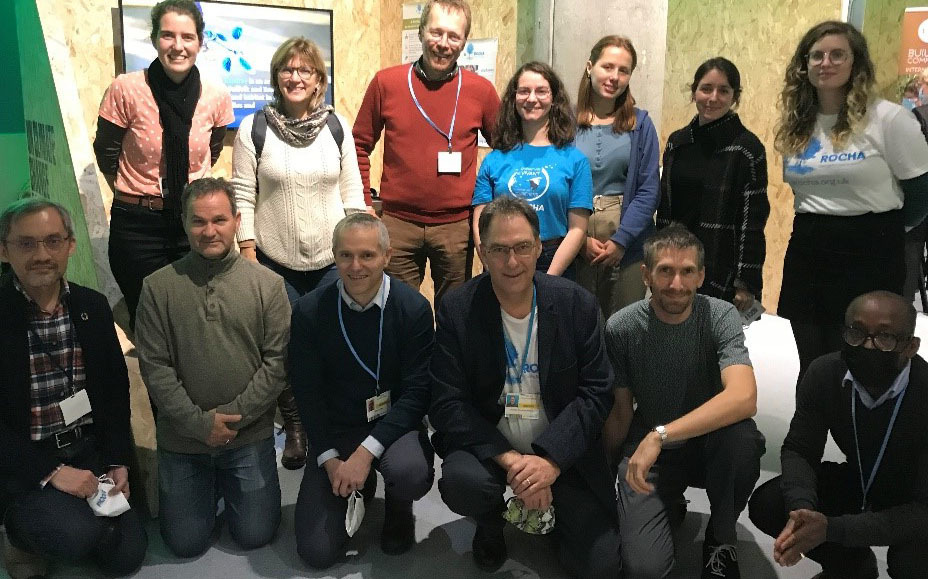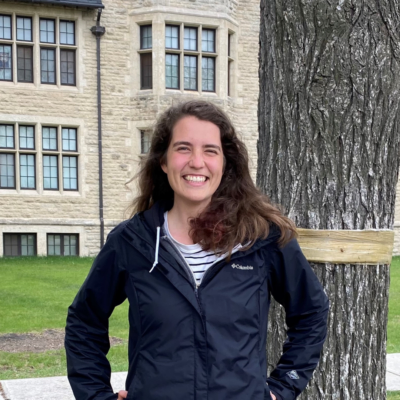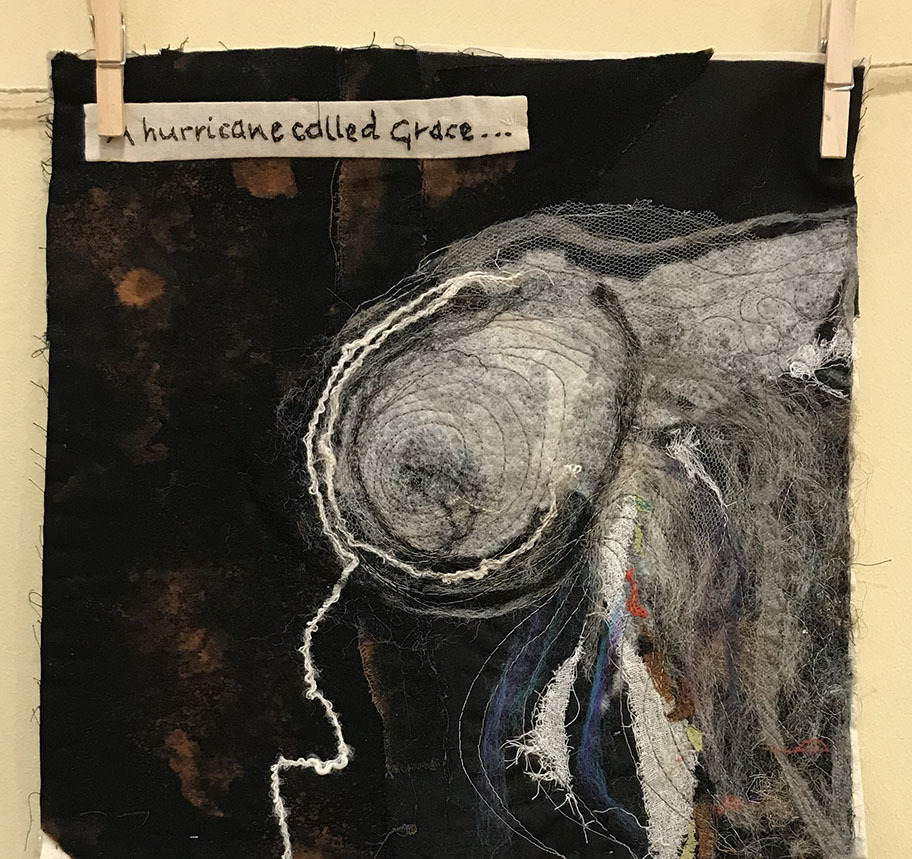

Kari Miller (back row, far left) at COP26 in Glasgow with A Rocha representatives from across the globe. Members from France, the U.K., Canada and Ghana are pictured.
 Kari Miller is the environmental education coordinator for A Rocha Manitoba and attends Home Street Mennonite in Winnipeg, Man. She attended COP26 in Glasgow, Scotland, from Nov. 5 to 12, 2021, as part of the Christian Climate Observers Program. I spoke with Miller about her experience at COP26, what she witnessed and what role she believes the church plays in the climate crisis.
Kari Miller is the environmental education coordinator for A Rocha Manitoba and attends Home Street Mennonite in Winnipeg, Man. She attended COP26 in Glasgow, Scotland, from Nov. 5 to 12, 2021, as part of the Christian Climate Observers Program. I spoke with Miller about her experience at COP26, what she witnessed and what role she believes the church plays in the climate crisis.
(Read Miller's reflection for Mennonite Church Canada before going to COP26.)
This interview has been edited for length and clarity.
Can you describe the work you do with A Rocha Manitoba?
I plan and implement curriculum for kids in outdoor education and nature-based learning. We run a drop-in program every Tuesday and a day camp on PD days for kids in the neighbourhood. We do outdoor scavenger hunts, teach wilderness skills like fire-building and fort-building, explore the Assiniboine Forest. We get them outside and curious about exploring their place.
What was your overall impression of COP26?
It's definitely overwhelming. There's a lot of people. I’m not well-versed in politics so it felt like learning a language. I had a badge as an observer that allowed me to enter spaces where countries were negotiating. Those meetings were fascinating to hear but also hard to understand as someone from civil society.
But overall I was impressed with how powerful civil society is. I met a number of inspiring folks who work with different A Rocha chapters around the globe. One person, Rachel Mander, has committed to not fly because it produces so much greenhouse gas. Before COP26 she did a 1000-mile pilgrimage where she walked from the southern tip of the U.K. where the G7 summit happened all the way up to Glasgow to bring awareness for the climate crisis.
On my final day there, on Nov. 12, many were frustrated that big decisions weren't being made at COP26, that countries weren't committing as much as people had expected. Some were calling COP26 a failure. At noon around hundreds of people (including observers) walked out in protest from the negotations, demanding more from COP. COP then proceeded to continue into Saturday and the Glasgow Climate pact was created. I think this walk-out was a big part of that. It pressured politicians and parties to make decisions and commitments.
Overall I was impressed with how powerful civil society is.
What was your day to day experience like? What did you do?
I went with a group called the Christian Climate Observers Program. CCOP is a coalition of Christian NGOs that came together and sent about 40 people as observers to the COP26. We stayed at a Bible retreat centre just outside of Glasgow. Each day we got up, had breakfast together and then did morning devotions. Then we caught the train into Glasgow.
There are two COP venues. The Green Zone is open to civil society; it has booths from a variety of NGOs, artwork, technology and panel discussions available to everyone. You need a pass to enter the Blue Zone. There’s two massive screens with a continual rolling schedule of all the meetings happening that day and what rooms they're in. You plan your day based on that list. The meetings happen from 8 a.m. to 8 p.m.
You mentioned the walkout that was important towards the end of the conference. Was there anything else that was a memorable moment for you or significant?
One of the most powerful moments I experienced was actually with the Quaker Church. It was right before COP. I had participated in the climate strike on Saturday, Nov. 6. It was cold and wet and raining and I accidentally stumbled into a Quaker church where there was a group of older women sewing patches onto a quilt. The patches showed the ways they cared for the environment. I went back the next day and actually helped them to create more patches. It was this beautiful moment of older women in standing in solidarity in their own way with people fighting against the climate crisis. It was impactful to see the wide variety of ways that people engage. These women weren't going to COP but they were standing up in their own way and making commitments in their own lives.
It was this beautiful moment of older women in standing in solidarity in their own way with people fighting against the climate crisis.
Can you give me an example of what was on the quilt those women were putting together?
The quilt was part of the Loving our Earth Project. One quilt piece was titled "A Hurricane called Grace." Hurricane Grace swept through this person's community and the pattern shows the hurricane. The story behind the patch is about how their community stepped up to help after the storm. It was her pledge to continue to work towards helping people affected by natural disasters, which have increased due to the climate change. (Scroll down for a photo of this quilt patch.)
Any other moments?
On Saturday, Nov. 13 many of the political leaders gave powerful speeches explaining how the climate crisis was affecting their countries. They are fearful their countries will become more vulnerable to natural disasters and they want to make the world a better place for their children.
I found these speeches incredibly moving and hard because in the end the Glasgow Climate Pact didn't live up to everything these leaders were hoping for. The target was to keep the global warming temperature at 1.5 degrees Celsius. The Pact moved that up to 2.4, which is dangerous for certain island countries that are threatened with being washed due to rising sea levels.
In your reflection for us before you left for COP26, you talked about feeling anxious because there was so much expectation placed on the conference. How do you feel now that you've had an inside look at what happens at a conference like that?
Both despair and hope have come to life for me in deeper ways. Despair in the sense that the climate crises is so much more real, now that I have heard those stories. Hope in the sense that I see action being taken—the women from the Quaker church who are quilting or Rachel Mander who walked across the U.K. That's where I'm reminded that there are people doing things to make change. Through them I'm reminded of our God who continues to create and redeem and I'm reminded of how nature is resilient through it all.
What role do you think the church plays in the climate emergency?
Just as I was describing hope, the church offers hope in a lot of ways. We can so easily look at numbers and feel the world slipping underneath our feet but the narrative of a God who still cares, is still present with us and is still redemptive, is huge in reminding us that our actions matter. The church offers liturgies of lament for us to be able to say, wow this is scary and this is hard. In the grief of the cross we can acknowledge our grief over the natural world. But then there’s the resurrection and I see in so many ways that we're continuing to push and to love and to see God's hand at work in this climate crisis and believe there's a better world on the other side.
The climate crisis is also a crisis of injustice because global warming disproportionately affects developing countries who are already vulnerable. The role of the church is to come alongside, to love our neighbours and to take care and walk with those who are more vulnerable.
But then there’s the resurrection and I see in so many ways that we're continuing to push and to love and to see God's hand at work in this climate crisis.
What do you take back to your own church community from this event?
If we aren't willing to act as individuals, then bigger policies will never actually change. When we participate in action, whether through little choices or by being part of climate strikes or bigger movements that pressures policymakers into making greener choices. That’s what I hope to bring back to the church, a reminder that our actions do matter in the end and to encourage everyone to keep making those green choices and keep building their relationships with the Earth.


A quilt patch made as part of the Loving our Earth Project, displayed at COP26.
Quilt patches from the Love for the Earth Project were displayed at COP26. The creator of the patch that Miller describes above wrote the following underneath her work:
"Around the world about 10,000 people die each year in hurricanes and tropical storms. As well as this trees, plants, land and sea animals, fish and birds face deadly conditions during a hurricane.
Whilst researching for this project I was astonished to find that one of these devastating occurrences was named Grace. Grace (eloquence or beauty of form, kindness, mercy, favour), which is derived from the Latin gratia (favour, thanks). The name was made popular by 17th-century Puritans, who bestowed it in reference to God's favour and love toward mankind. I wondered what led those who name such destructive forces to use this highly unsuitable name.
When occuring naturally, climate change is a slow process that has taken place over thousands of years. The human influenced climate change that is happening now is occurring at a much faster rate and according to a scientist on BBC Radio4 (July 2021) is upon us right now. I am in my mid-seventies; my interest in doing the little I can to mitigate against these changes is because of my grandchildren and their children and wondering what on earth their lives will be like if those responsible don't.
In my own small way as well as being a vegetarian and growing some of my own food, shopping with an awareness of recycling, I have always been vigorous in my attempts to conserve water by trying very hard not to waste any."